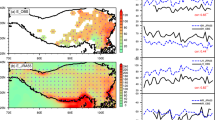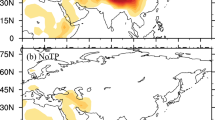Abstract
The heat-driven plain–plateau circulation producing strong summertime winds in Yerevan has been examined. The study indicates that the formation of plain–plateau circulation over the Armenian Highland is the combined product of large-scale and local circulations. There is significant enhancement of the westerly subtropical jet over the study region, Caspian Sea and further to the east in the upper troposphere in days with severe wind gusts in Yerevan. Further, the influence of major monsoon systems (Indian and African) on the plain–plateau circulation over the Armenian Highland is considered in this study. Both observations and ERA-Interim reanalysis data show the existence of intense heat source over the southeastern and southern parts of the Armenian Highland which produces an extra daytime warming exceeding 2.1 °C on average at the ground surface during days with severe gusts in Yerevan. This warm center is maintained through 700 hPa level and it disappears in the middle and upper troposphere. The plateau atmospheric boundary layer can extend beyond 4,000 m above mean sea level (up to the middle troposphere) during the afternoon. By contrast, exposed mountain ranges stretching along the Black and Caspian seas are characterized by significant negative temperature differences. It should be noted that ERA-Interim reanalysis data strongly underestimate the significant negative differences in mean daytime temperatures over northeastern, southeastern parts of Armenia and over Sevan Lake basin found in observed data. The results suggest intensification of the plain–plateau circulation over the Armenian Highland induced by recent surface warming over the study region. Temperature projections over the study region for the twenty-first century show that the enhancement of the plain–plateau circulation can be expected under future climate conditions.

















Similar content being viewed by others
References
Banta RM (1984) Daytime boundary-layer evolution over mountainous terrain. Part I: observations of the dry circulations. Mon Weather Rev 112:340–356
Berrisford P, Dee D, Poli P, Brugge R, Fielding K, Fuentes M, Kallberg P, Kobayashi S, Uppala S, Simmons A (2011) The ERA-interim archive: Version 2.0. ERA Report Series 1:23
Birch CE, Parker DJ, Marsham JH, Devine GM (2012) The effect of orography and surface albedo on stratification in the summertime Saharan boundary layer: dynamics and implications for transport. Geophys Res Lett 117:1–13
Chen H, Suna J, Chen X (2013) Projection and uncertainty analysis of global precipitation-related extremes using CMIP5 models. Int. J. Climatol. doi:10.1002/joc.3871
Dee D, Uppala SM, Simmons AJ, Berrisford P, Poli P, Kobayashi S, Andrae U, Balmaseda MA, Balsamo G, Bauer P, Bechtold P, Beljaars ACM, van de Berg L, Bidlot J, Bormann N, Delsol C, Dragani R, Fuentes M, Geer AJ, Haimberger L, Healy SB, Hersbach H, H´aolm EV, Isaksen L, Kallberg P, Kohler M, Matricardi M, McNally AP, Monge-Sanz BM, Morcrette JJ, Park BK, Peubey C, de Rosnay P, Tavolato C, Thepaut JN, Vitart F (2011) The ERA-interim reanalysis: configuration and performance of the data assimilation system. Q J R Meteorol Soc 137:553–597
Elguindi N, Somot S, De´que´ M, Ludwig W (2011) Climate change evolution of the hydrological balance of the Mediterranean, Black and Caspian Seas: impact of climate model resolution. Clim Dyn 36:205–228
Elliott D, Schwartz M, Scott G, Haymes S, Heimiller D, George R (2003) Wind energy resource Atlas of Armenia. U.S. Agency for International Development, p 169
Evans JP, Smith RB, Oglesby RJ (2004) Middle East climate simulation and dominant precipitation processes. Int J Climatol 24:1671–1694
Gent PR, Danabasoglu G, Donner LL, Holland MM, Hunke EC, Jayne SR, Lawrence DM, Neale RB, Rasch PJ, Vertenstein M, Worley PH, Yang Z-L, Zhang M (2011) The community climate system model version 4. J Clim 24:4973–4991
Gevorgyan A (2012) Verification of daily precipitation amount forecasts in Armenia by ERA-Interim model. Int J Climatol 33(12):2706–2712
Gevorgyan A (2013) Main types of synoptic processes and circulation types generating heavy precipitation events in Armenia. Meteorol Atmos Phys 122:91–102
Gevorgyan A (2014) Surface and tropospheric temperature trends in Armenia. Int J Climatol. doi:10.1002/joc.3928
Gevorgyan A, Melkonyan H, Aleksanyan T, Iritsyan A, Khalatyan Ye (2014) Temperature change projection in Armenia: CCSM4 model. Theor Appl Climatol (submitted)
Hafner TA, Reinhardt Weisel EL, Fimpel HP (1987) Boundary layer aspects and elevated heat source effects of the Alps. Meteorol Atmos Phys 36:61–73
Luo H, Yanai M (1984) The large-scale circulation and heat sources over the Tibetian plateau and surrounding areas during the early summer of 1979. Part II: heat and moisture budgets. Mon Weather Rev 112:966–989
Meleshko VP, Govorkova VA (2013) Performance of CMIP3 and CMIP5 models in simulation of current climate. Trans Voeykov Main Geophys Obs 568:26–51
Melkonyan G, Ovsepyan A, Irityan A, Khalatyan E, Gevorgyan A (2013) Climate change assessment in Armenia. Trans Inst Hydrometeorol Georgian Tech Univ 119:33–37
Melkonyan H, Gevorgyan A, Iritsyan A, Khalatyan Ye, Aleksanyan T (2014) Updated climate change scenarios for Armenia. Trans. Yerevan State Univ. (Submitted)
Messager C, Parker DJ, Reitebuch O, Agusti-Panareda A, Taylor CM, Cuesta J (2010) Structure and dynamics of the Saharan atmospheric boundary layer during the West African monsoon onset: observations and analyses from the research flights of 14 and 17 July 2006. Q J R Meteorol Soc 136:107–124
Mkhitaryan A, Zoryan Z (1974) Simulation of meteorological fields over Armenia for wind forecasts in the lower troposphere. Transcaucasus Hydrometeorological Research Institute, p 32
Moss RH, Edmonds JA, Hibbard KA, Manning MR, Rose SK, van Vuuren DP, Carter TR, Emori S, Kainuma M, Kram T, Meehl GA, Mitchell JFB, Nakicenovic N, Riahi K, Smith SJ, Stouffer RJ, Thomson AM, Weyant JP, Wilbanks TJ (2010) The next generation of scenarios for climate change research and assessment. Nature 463:747–756. doi:10.1038/nature08823
Pavlova TV, Kattsov VM (2013) World ocean ice cover as simulated with CMIP5 models. Trans Voeykov Main Geophys Obs 568:7–26
Rao GV, Erdogan S (1989) The atmospheric heat source over the Bolivian plateau for a mean January. Bound Layer Meteorol 46:13–33
Regional Climate Change Impacts Study for the South Caucasus Region (2011) Tbilisi
Rizou D, Flocas HA, Bartzokas A, Helmis CG (2013) On the link between Indian summer monsoon and the Etesian pattern over the Aegean Sea. Proceedings of the 13th International Conference on Environmental Science and Technology: Athens, Greece, 5–7 September 2013
Rodwell MJ, Hoskins BJ (1996) Monsoons and the dynamics of deserts. Q J R Meteorol Soc 122:1385–1404
Sato T, Kimura F (2005) The impact of diabatic heating over the Tibetan plateau upon northeastern Asia arid region. Geophys Res Lett 32(5):966–970
Selezneva ES (1958) On formation of northward summertime winds in the Sevan Lake basin. Proc Voeikov Main Geophys Obs 78:77–83
Smith RK, Spengler T (2011) The dynamics of heat lows over elevated terrain. Q J R Meteorol Soc 137:250–563
Sporyshev PV, Govorkova VA (2013) Temperature changes in Russia according to observations and model simulations with a separate account of anthropogenic and natural external impacts. Trans Voeykov Main Geophys Obs 568:51–80
Traub M, Lelieveld J (2003) Cross-tropopause transport over the eastern Mediterranean. J Geophys Res 180. doi:10.1029/2003JD003754
Tyrlis E, Lelieveld J, Steil B (2013) The summer circulation over the eastern Mediterranean and the Middle East: influence of the South Asian monsoon. Clim Dyn 40:1103–1123
von Hann J (1915) Lehrbuch der Meteorologie (Textbook of Meteorology). Tauchnitz Verlag: p 847
Wang L, Chen W (2013) A CMIP5 multimodel projection of future temperature, precipitation, and climatological drought in China. Int J Climatol 34:2059. doi:10.1002/joc.3822
Wilks DS (2006) Statistical methods in the atmospheric sciences. Elsevier, Burlington
Yang K, Koike T, Fujii H, Tamura T (2004) The daytime evolution of the atmospheric boundary layer and convection over the Tibetian plateau: observations and simulations. J Meteorol Soc Jpn 82(6):1777–1792
Ye D (1981) Some characteristics of the summer circulation over the Qinghai-Xizang (Tibet) plateau and its neighboring. Bull Am Meteorol Soc 62(1):14–19
Zaitchik BF, Evans JP, Smith RB (2007) Regional impact of an elevated heat source: the Zagros plateau of Iran. J Clim 20:4133–4146
Zangl G, Chico SG (2006) The thermal circulation of s Grand Plateau: sensitivity to the height, width, and shape of the plateau. Mon Weather Rev 134:2581–2600
Zarrin A, Ghaemi H, Azadi M, Mofidi A, Mirzaei E (2011) The effect of the Zagros mountains on the formation and maintenance of the Iran anticyclone using RegCM4. Meteorol Atmos Phys 112:91–100
Zhang X, Aguilar E, Sensoy S, Melkonyan H et al (2005) Trends in Middle East climate extreme indices from 1950 to 2003. Geophys Res Lett 110:D22. doi:10.1029/2005JD006181
Ziv B, Saaroni H, Alpert P (2004) The factors governing the summer regime of the eastern Mediterranian. Int J Climatol 24:1859–1871
Zoryan Z (1974) Prediction of summertime severe winds in Yerevan. Transcaucasus Hydrometeorological Research Institute, p 47
Author information
Authors and Affiliations
Corresponding author
Electronic supplementary material
Below is the link to the electronic supplementary material.
Rights and permissions
About this article
Cite this article
Gevorgyan, A., Melkonyan, H. Regional impact of the Armenian highland as an elevated heat source: ERA-Interim reanalysis and observations. Clim Dyn 44, 1541–1565 (2015). https://doi.org/10.1007/s00382-014-2236-z
Received:
Accepted:
Published:
Issue Date:
DOI: https://doi.org/10.1007/s00382-014-2236-z




